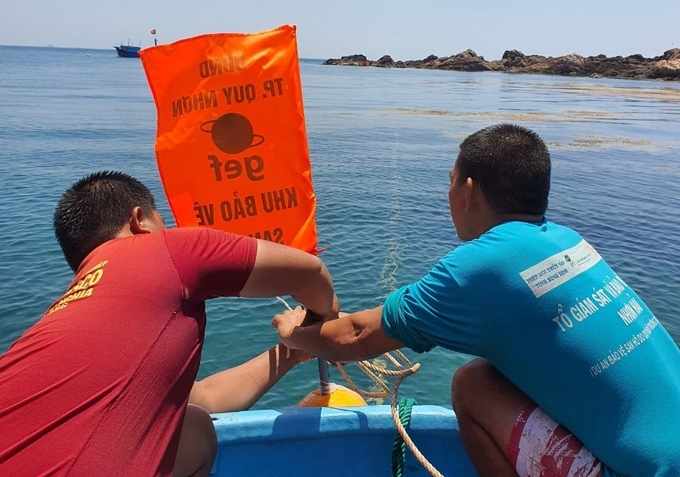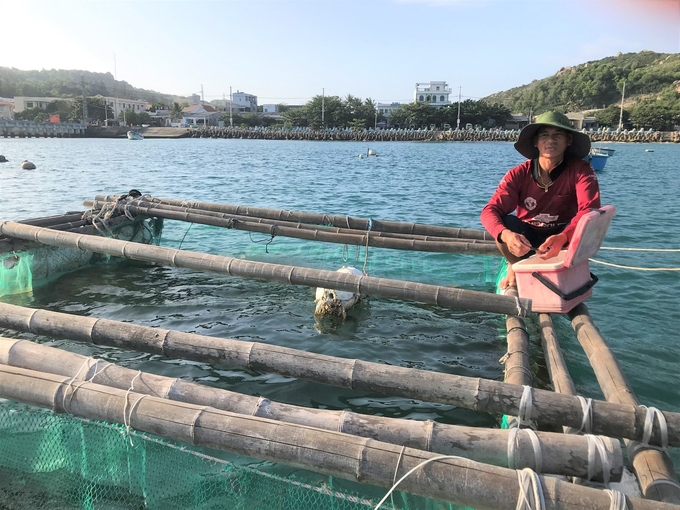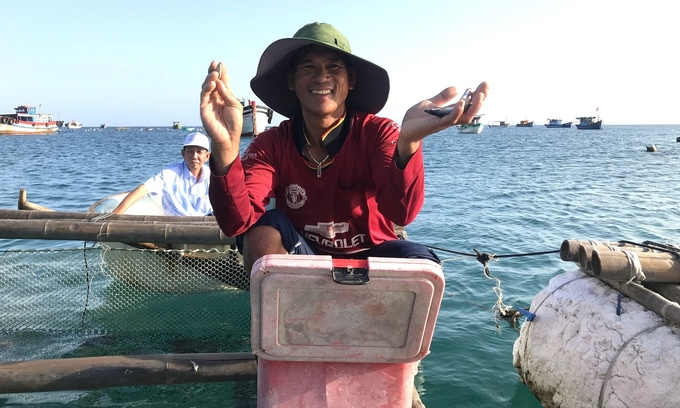November 28, 2025 | 03:35 GMT +7
November 28, 2025 | 03:35 GMT +7
Hotline: 0913.378.918
November 28, 2025 | 03:35 GMT +7
Hotline: 0913.378.918
Previously, in Cu Lao Xanh (administrative name is Nhon Chau commune) in Quy Nhon city (Binh Dinh) there were 51 households raising lobster, white pomfret, turtle fish, grouper, and greater amberjack. In 2010, after visiting bigfin reef squid farming models in Nhon Ly and Nhon Hai communes (Quy Nhon city), some households in Nhon Chau started raising squid. From a few initial farming households, currently in Nhon Chau island commune 18 households are raising bigfin reef squid with 31 rafts on the sea in front of the island.
In Nhon Chau commune, there is a Community Group for protecting aquatic resources with 50 members. The community group's activities mainly protect aquatic resources in the waters around the island, protect coral and protect the marine waters of local people.
According to Mr. Nguyen Ha Lao, Chairman of the Farmers' Association of Nhon Chau commune, the community group to protect aquatic resources in this commune regularly coordinates with the authorities to patrol and inspect the waters around the island. This is to prevent boats from entering and fishing in waters with an area of more than 20 ha. Quy Nhon City People's Committee has assigned management authority of more than 2 ha of sea surface with coral reefs in this sea area to the commune community group.

The community group protecting aquatic resources in Nhon Chau island commune releases buoys to protect the sea area assigned to management by the People's Committee of Quy Nhon City (Binh Dinh). Photo: V.D.T.
Particularly for the area of more than 2 ha in front of the beach, there is a coral reef that is more strictly protected by the community group. In this sea area, there are also signs prohibiting boats from visiting. In addition to the task of preventing boats from fishing in waters assigned with protection, the community group also prevents diving activities to catch seafood, especially coral exploitation and protects the marine environment where people are raising squid and fish.
Also according to Mr. Nguyen Ha Lao, the activities of the Community Group for protecting aquatic resources in Nhon Chau commune, in addition to protecting coastal aquatic resources, contribute to preserving the environment of coastal areas and sea-farming islanders. Boats do not operate in this sea area, which means that no garbage on boats is discharged into the sea, especially, to avoid damaging the sea cages of people.
“Every day, in addition to instructing tourists to scuba dive not to violate the coral, the community group also reminds tourists not to throw trash into the sea, causing water pollution. Thanks to that, the water source in the front beach area, where people do farming the sea, is very well protected", said Mr. Nguyen Ha Lao.
Also according to Mr Lao, the phenomenon of people in Nhon Chau dumping household waste into the sea is no longer like before, people's awareness of protecting the marine environment is increasingly rising. Household waste is collected by people, and every day there are vehicles from the garbage collection team doing clean-up tasks.

Leaf squid farmers in Nhon Chau island commune (Quy Nhon city, Binh Dinh) abandoned the habit of storing bait fish in plastic bags for the squid to eat, instead, they put it in a plastic container to protect the marine environment. Photo: V.D.T.
The environment of farming waters is also strictly protected by squid farmers. Bigfin reef squid's food is fresh bait, including marine fish. Currently, in Nhon Chau, there are 31 rafts raising leaf squid, on average each raft has 2 squid farming nets, and each net holds about 150 squids. For every 10 net cells, 1,500 squids are raised, each day they consume about 30kg of bait.
According to Mr Tran Van Cho, one of the pioneers of leaf squid farming in Nhon Chau island commune, any squid farming household that has someone fishing near the shore does not have to buy bait. When the catch is not enough for the squid to eat, they will go to Quy Nhon to buy scrap fish for VND 20,000-25,000/kg. Squids eat twice a day, in the morning and afternoon.
Every early morning, the farmer sits on the shore, cuts the fish into small pieces, puts them in a plastic bucket and takes them to the raft to feed the squid, then the farmer brings the bucket to shore. In the past, farmers had the habit of putting bait in plastic bags, bringing them to the raft for the squid to eat, and then throwing the plastic bags into the sea. Over time, the plastic bags containing food for squid mentioned above will pollute the sea. Changing this habit has contributed to protecting the environment of squid farming waters in Nhon Chau commune.

Leaf squid farmers in Nhon Chau island commune (Quy Nhon city, Binh Dinh) do not let squid leftover food pollute the farming area. Photo: V.D.T.
According to Mr. Nguyen Van Tro (63 years old) in Tay village, raising squid is the most difficult part of feeding the squid, which takes up to several hours each time. When he first raised squid, because he had no experience, Mr. Tro gave a few dozen kilograms of fish scraps as food for the squid at once. Before the squid could eat, the fish sank to the bottom of the net. When the fish has sunk to the bottom of the net, no matter how good the bait is, the squid will not eat it.
Squids only eat floating prey, so food must be released slowly so that every squid gets the same amount of food. If feeding is not done carefully, if one is full while the others are hungry, the hungry squids will eat the smaller squids in the cage. After feeding the squid, if there is still leftover food left at the bottom of the net, the owner must use a net to scoop it all up to avoid polluting the water source.
“Every time squid are fed, cobia in the wild gather outside the squid nets, waiting to eat the squid's leftover food that has sunk to the bottom of the net. Although separated by a thick net, it is unknown how the cobia cleans the fish. Invisibly, cobia contributes to cleaning the environment of squid farming waters", shared Mr Tran Van Cho, who is raising 1,500 squids in each batch in Nhon Chau.
Translated by Hoang Duy

(VAN) According to Mr. Vo Minh Thanh, Director of the Tay Ninh Department of Agriculture and Environment, Resolution 57 has created a new development pathway for the locality, shifting from traditional toward modern agriculture.
/2025/11/26/4909-2-154329_878.jpg)
(VAN) Pearl grouper farming in HDPE cages not only delivers economic efficiency but also contributes to protecting the environment, creating jobs, and promoting marine-based experiential tourism.

(VAN) The model of making a living under the forest canopy through the agroforestry system in Van Son commune, Bac Ninh province, is expected to generate an annual income of approximately VND 30 million/ha.

(VAN) Many enterprises in Can Tho are harnessing natural energy and reducing greenhouse gas emissions in their production processes, thereby contributing to the promotion of a sustainable green transition.
/2025/11/24/3536-2-112800_176.jpg)
(VAN) Dong Nai now has tens of thousands of hectares of forests certified for sustainable management, and this area will continue to be expanded in the coming period.

(VAN) Vinh Ha hamlet (Dai Xuyen commune, Hanoi) is shifting away from small-scale farming as households adopt bioscurity into their breeder chicken models.

(VAN) Heavy rains make aquatic species more vulnerable to disease. Proactive water management and high-tech systems help farmers prevent outbreaks and protect yields.